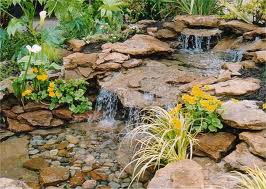





“I have a natural stream that has wildly varying water levels. After a thaw during the winter, it can become a raging torrent and cause considerable damage to my waterside planting. What is the best way of controlling this erosion?”
 There are several options that can be adopted when planting is not sufficient to prevent erosion, but wood is the easiest and most tasteful to use. With a little ingenuity, it is often possible to drive in stakes and erect boards in the water, close to the muddy banks. This will allow you to reclaim an area of nutrient-rich soil, which is ideal for growing moisture-loving perennials.
There are several options that can be adopted when planting is not sufficient to prevent erosion, but wood is the easiest and most tasteful to use. With a little ingenuity, it is often possible to drive in stakes and erect boards in the water, close to the muddy banks. This will allow you to reclaim an area of nutrient-rich soil, which is ideal for growing moisture-loving perennials.
Take strong stakes, which have been treated with a non-toxic wood preservative, and hammer them into the stream bed along the desired line of the bank. Then place preservative-treated wooden boards between the stakes and the eroded bank, building them up to the level of the surrounding ground. Backfill the eroded area between the boards and the bank with soil. This area can then be planted, and the wooden boards disguised with scrambling plants.
“I do not have enough room for a proper stream in my garden, but in some old gardens I have seen a series of channels that link to a water feature. How would I go about constructing such channels?”
A popular feature in many old gardens was a wall mask spouting into a small pool, which was connected to a number of channels that flowed through the garden into a lower pool. Usually, these had quite a steep slope and the water raced down them. Their finished size was rarely more than 30cm (12in) deep and 30cm (12in) wide.
To create such a feature, dig out a trench 15cm (6in) wider and 10cm (4in) deeper than the finished structure. Construct simple shuttering boards to form a mould within the trench. Concrete the floor of the trench and press wire netting into the wet concrete as reinforcement. Position the shuttering and fill behind it to create the walls, ensuring that the concrete is tamped down firmly. As the concrete dries, periodically sprinkle it with water from a watering can fitted with a fine rose. This will prevent the drying process from being too rapid, which could lead to the formation of hairline cracks in the surface of the concrete.
“I have a spring in my garden; how can I turn it into a moving water feature?”
This rather depends on how permanent the spring is, and how constant its flow. If the latter is irregular or inconsistent in any way, it is best to allow the spring to feed directly into a pool, which is allowed to overflow into a small watercourse. The resulting feature could provide a useful habitat for bog garden plants.
If you are satisfied that the spring flows freely all year round, treat it rather like a permanent water supply and direct it into a stream or waterfall. Of course, it will need an outlet and must be permitted to run into a land drain, which should be contrived in a discreet manner.
The problem with using spring water, even if there is a consistent flow, is coping with the inevitable wealth of nutrients that it will bring with it. A constant fresh supply of plant foods will encourage the rapid development and continuous growth of algae, especially the green water-discolouring types. This will not manifest itself in the stream or waterfall so much as in any permanent pond feature. Therefore, it is best to treat a spring as a purely decorative moving water feature, which should be separated completely from any water garden development.
Copyright © www.100flowers.win Botanic Garden All Rights Reserved